Magnesia on the Maeander
Magnesia or Magnesia on the Maeander (Ancient Greek: Μαγνησία ἡ πρὸς Μαιάνδρῳ or Μαγνησία ἡ ἐπὶ Μαιάνδρῳ; Latin: Magnḗsĭa ad Mæándrum) was an ancient Greek city in Ionia, considerable in size, at an important location commercially and strategically in the triangle of Priene, Ephesus and Tralles. The city was named Magnesia, after the Magnetes from Thessaly who settled the area along with some Cretans. It was later called "on the Meander" to distinguish it from the nearby Lydian city Magnesia ad Sipylum. It was earlier the site of Leucophrys mentioned by several ancient writers.[1]
Μαγνησία ἡ πρὸς Μαιάνδρῳ | |
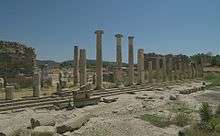 The Propylaea of Magnesia on the Maeander | |
 Shown within Turkey  Magnesia on the Maeander (Near East) | |
| Location | Tekin, Aydın Province, Turkey |
|---|---|
| Region | Ionia |
| Coordinates | 37°51′10″N 27°31′38″E |
| Type | Settlement |
| History | |
| Builder | Magnetian and Cretan settlers |
| Cultures | Greek, Roman |
| Associated with | Bathycles of Magnesia, Themistocles, Saint Lazarus of Magnesia |
| Site notes | |
| Excavation dates | 1891–1893, 1984–present |
| Archaeologists | Carl Humann, Orhan Bingöl |
| Condition | Ruined |
| Ownership | Public |
| Public access | Yes |
The territory around Magnesia was extremely fertile, and produced excellent wine, figs, and cucumbers.[2] It was built on the slope of Mount Thorax,[3] on the banks of the small river Lethacus, a tributary of the Maeander river upstream from Ephesus. It was 15 miles from the city of Miletus.[4][5] The ruins of the city are located west of the modern village Tekin in the Germencik district of Aydın Province, Turkey.
Magnesia lay within Ionia, but because it had been settled by Aeolians from Greece, was not accepted into the Ionian League. Magnesia may have been ruled for a time by the Lydians,[6] and was for some time under the control of the Persians, and subject to Cimmerian raids. In later years, Magnesia supported the Romans in the Second Mithridatic War.[7][8]
General history
Magnesia soon attained great power and prosperity, so as to be able to cope even with a challenge from Ephesus.[9] However, the city was taken and destroyed by the Cimmerians, some time between 726 BC and 660 BC. The deserted site was soon reoccupied, and rebuilt by the Milesians or, according to Athenaeus,[10] by the Ephesians. The Persian satraps of Lydia also occasionally resided in the place.[11]

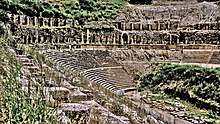
In the fifth century BC, the exiled Athenian Themistocles came to Persia to offer his services to Artaxerxes, and was given control of Magnesia to support his family.[12]
The name "magnet" may come from lodestones found in Magnesia.[13]
In the time of the Romans, Magnesia was added to the kingdom of Pergamon, after Antiochus had been driven eastward beyond Mount Taurus.[14] After this time the town seems to have declined and is rarely mentioned, though it is still noticed by Pliny[15] and Tacitus.[16] Hierocles[17] ranks it among the bishoprics of the province of Asia, and later documents seem to imply that at one time it bore the name of Maeandropolis.[18] The existence of the town in the time of the emperors Aurelius and Gallienus is attested to by coins.
Landmarks
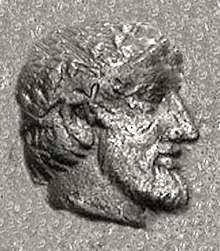
Magnesia contained a temple of Dindymene, the mother of the gods; the wife or daughter of Themistocles was said to have been a priestess of that divinity.
Strabo later noted [19] the temple no longer existed, the town having been transferred to another place. The change in the site of the town alluded to by Strabo, is not noticed by other contemporary authors, however some suggest that Magnesia was moved from the banks of the Meander to a place at the foot of Mount Thorax three miles from the river.[20]
The new town which Strabo saw was remarkable for its temple of Artemis Leucophryene (Ancient Greek: Ἄρτεμις Λευκοφρυηνή), which in size and the number of its treasures was surpassed by the temple of Ephesus, but in beauty and the harmony of its parts was superior to all the temples in Asia Minor:
- "The first city one comes to after Ephesos is Magnesia, which is an Aiolian city . . . In the present city is the temple of Artemis Leukophryene, which in the size of its shrine and in the number of its votive offerings is inferior to the temple at Ephesos, but in the harmony and skill shown in the structure of the sacred enclosure is far superior to it. And in size it surpasses all the sacred enclosures in Asia except two, that [of Artemis] at Ephesos and that [of Apollon] at Didymoi."[21]
The temple to Artemis is said by Vitruvius [22] to have been built by the architect Hermogenes, in the Ionic style. Following a theophany of the goddess Artemis in the 3rd century B.C., the temple and the city were recognised as a place of asylia by other Greek states. [23]
The temples of the city would have been closed during the persecution of pagans in the late Roman Empire and little remains of either temple today. The site of Magnesia on the Maeander was once identified with the modern Güzelhisar; since then the ruins of a temple to Artemis were found at Inck-bazar, and the latter is considered a more likely site.
Modern excavations
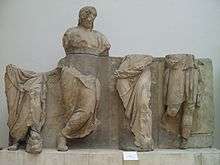
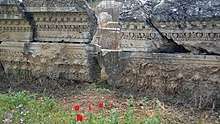
The first excavations at the archaeological site were performed during 1891 and 1893 by a German archaeological team conducted by Carl Humann, discoverer of the Pergamon Altar. These lasted 21 months and partially revealed the theatre, the Artemis temple, the agora, the Zeus temple and the prytaneion. Excavations were resumed at the site, after an interval of almost 100 years, in 1984, by Orhan Bingöl of the University of Ankara and the Turkish Ministry of Culture.
Findings from the site are now displayed in Istanbul and Aydın, as well as in Berlin and Paris. Copies of the portico (pronaos) of the Zeus temple and of a bay of the Artemis temple can be visited in the Pergamonmuseum in Berlin. Much of the architectural remains of Magnesia were destroyed long ago by local lime burners. The well preserved remains of the Zeus temple have been destroyed by local residents even after Humann's excavation campaign.
In July 2018, six Greek statues were discovered. Four female, one male and one with unknown gender were unearthed in the ruins of a temple of Artemis.[24]
Notable people
- Bathycles (6th century BC) Greek sculptor
- Themistocles of Athens spent his final years and was buried here
- Protophanes (Πρωτοφάνης) ancient victor of both wrestling and Pankration[25]
Sources
- Carl Humann: Magnesia am Maeander. Bericht über die Ergebnisse der Ausgrabungen der Jahre 1891–1893. Berlin: Reimer, 1904
- Volker Kästner: Der Tempel des Zeus Sosipolis von Magnesia am Mäander, in: Brigitte Knittlmayer and Wolf-Dieter Heilmeyer: Die Antikensammlung, Mainz: Philipp von Zabern, 1998, p. 230-231
- Johannes Althoff: Ein Meister des Verwirklichens. Der Archäologe Theodor Wiegand, in: Peter Behrens, Theodor Wiegand und die Villa in Dahlem. Klaus Rheidt and Barbara A. Lutz (ed.), Mainz: Philipp von Zabern, 2004, p. 151
Literary references
- Magnesia on the Maeander is the location for the historical mystery novel The Ionia Sanction, by Gary Corby, set during the last days of Themistocles.
See also
References
- General
- In Smith, W. (1854). Dictionary of Greek and Roman geography. Boston: Little, Brown & Co Page 252
- Footnotes
- Lund University. Digital Atlas of the Roman Empire.
- Athen. i. p. 29, ii. p. 59, iii. p. 78.
- John Pinkerton (1811). A general collection of ... voyages and travels, digested by J. Pinkerton. pp. 663–.
- Strabo xiv. pp. 636, 647; Plin. v. 31.
- image showing the location of Magnesia Archived 2011-09-29 at the Wayback Machine (in Asia Minor).
- There are references to its capture by King Gyges, however this may refer to the original conquering of Magnesia ad Sipylum, long a Lydian city. See for instance .
- Thomas Allom; Robert Walsh; John Chippendall Montesquieu Bellew; Mark Wilson (2006). Thomas Allom's Constantinople and the Scenery of the Seven Churches of Asia Minor. Gorgias Press. pp. 210–. ISBN 978-1-59333-139-9.
- Handbook for Travellers in Turkey in Asia: Including Constantinople, the Bosphorus, Plain of Troy, Isles of Cyprus, Rhodes, &c..., with General Hints for Travellers in Turkey, Vocabularies &c. J. Murray. 1878. pp. 290–.
- Callinus, ap. Strabo xiv. p. 647.
- xii. p. 525
- Herod, i. 161, iii. 122.
- Nepos, Themist. 10; Diod. xi. 57.
- Paul Hewitt, "Conceptual Physics". 10th ed. (2006), p.458
- Liv. xxxvii. 45, xxxviii. 13.
- v. 31
- Ann. iv. 55
- p. 659
- Concil. Constantin. iii. p. 666.
- Strab. xiv. 1.40 (p. 647)
- Ancient Turkey: A Traveller's History, by Seton Lloyd, p151.
- Strabo, Geography 14. 1. 40
- Vitr. vii. Praefat.12
- Syll.³ 554 and Syll.³ 557- Greek inscriptions in English translation.
- Six 2000-year-old Greek statues discovered in southwestern Turkey
- Pausanias, Description of Greece, 5.21.10
| Wikimedia Commons has media related to Magnesia on the Maeander. |